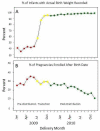Community based weighing of newborns and use of mobile phones by village elders in rural settings in Kenya: a decentralised approach to health care provision
- PMID: 22429731
- PMCID: PMC3344691
- DOI: 10.1186/1471-2393-12-15
Community based weighing of newborns and use of mobile phones by village elders in rural settings in Kenya: a decentralised approach to health care provision
Abstract
Background: Identifying every pregnancy, regardless of home or health facility delivery, is crucial to accurately estimating maternal and neonatal mortality. Furthermore, obtaining birth weights and other anthropometric measurements in rural settings in resource limited countries is a difficult challenge. Unfortunately for the majority of infants born outside of a health care facility, pregnancies are often not recorded and birth weights are not accurately known. Data from the initial 6 months of the Maternal and Neonatal Health (MNH) Registry Study of the Global Network for Women and Children's Health study area in Kenya revealed that up to 70% of newborns did not have exact weights measured and recorded by the end of the first week of life; nearly all of these infants were born outside health facilities.
Methods: To more completely obtain accurate birth weights for all infants, regardless of delivery site, village elders were engaged to assist in case finding for pregnancies and births. All elders were provided with weighing scales and mobile phones as tools to assist in subject enrollment and data recording. Subjects were instructed to bring the newborn infant to the home of the elder as soon as possible after birth for weight measurement.The proportion of pregnancies identified before delivery and the proportion of births with weights measured were compared before and after provision of weighing scales and mobile phones to village elders. Primary outcomes were the percent of infants with a measured birth weight (recorded within 7 days of birth) and the percent of women enrolled before delivery.
Results: The recorded birth weight increased from 43 ± 5.7% to 97 ± 1.1. The birth weight distributions between infants born and weighed in a health facility and those born at home and weighed by village elders were similar. In addition, a significant increase in the percent of subjects enrolled before delivery was found.
Conclusions: Pregnancy case finding and acquisition of birth weight information can be successfully shifted to the community level.
Figures



References
-
- Abbatt F. Scaling Up Health And Education Workers: Community Health Workers: Literature Review. DFID Health Systems Resource Centre; 2005.
-
- Celletti F, Wright A, Palen J, Frehywot S, Markus A, Greenberg A, de Aguiar RA, Campos F, Buch E, Samb B. Can the deployment of community health workers for the delivery of HIV services represent an effective and sustainable response to health workforce shortages? Results of a multicountry study. AIDS. 2010;24(Suppl 1):S45–57. doi: 10.1097/01.aids.0000366082.68321.d6. - DOI - PubMed
-
- Dhaene G, Goufack J, Tatah EA. The Douala Action Plan. Human resource for Health in Africa, Experiences Challenges and Realities. Geneva 27, Switzerland: WHO; 2008.
Publication types
MeSH terms
Grants and funding
LinkOut - more resources
Full Text Sources
Medical

